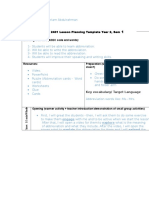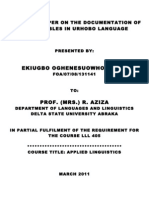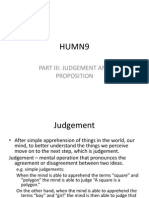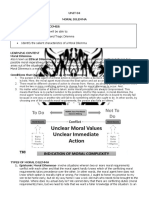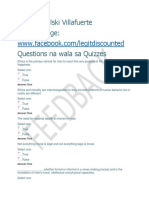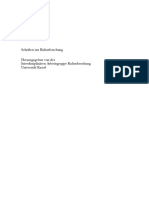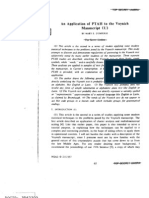HPHILOG
HPHILOG
Uploaded by
HarumiJaneCopyright:
Available Formats
HPHILOG
HPHILOG
Uploaded by
HarumiJaneOriginal Description:
Copyright
Available Formats
Share this document
Did you find this document useful?
Is this content inappropriate?
Copyright:
Available Formats
HPHILOG
HPHILOG
Uploaded by
HarumiJaneCopyright:
Available Formats
AUSTRIA, Arvie Jane G.
ARC111
HPHILOG Instructor: Christine Tan
4. Spiritual
5. Constant
INTRODUCTION TO LOGIC
Etymological Definition of Logic
Zeno the Stoic first coined the word logic.
Logic came from the Greek term:
( logike ) which means a thought
Etymologically, logic means a treatise pertaining to thought.
Aristotle considered Logic as the organon or the tool or
instrument of the sciences.
Logic is the instrument for gaining knowledge or the tool for
correct thinking
Logic is the instrument for gaining knowledge or the tool for
correct thinking.
Formal Definition:
Logic is the study of science and art of correct inferential
reasoning.
Logic deals with the laws, methods and
principles of correct thinking.
Thereby, logic distinguishes correct from incorrect
reasoning.
It is a science because it is a systematized body of
knowledge about the principles and laws of correct
inferential reasoning. It follows certain rules and
laws in arriving at valid conclusions.
Logic is also considered art, the art of reasoning.
As an art it requires the mastery of the laws and
principles of correct inferential thinking.
Formal and Material Logic
Formal Logic discusses the conceptual patterns or
structures needed for a valid and correct argument or
inference. It deals with the correct patterns of argumentation.
Material Logic deals with the nature of the terms and
propositions that are used in the different types of inference.
It discusses the types ad meanings of terms or words and
sentences or propositions used in the arguments.
The Three-fold Intellectual Acts:
Intellectual Acts
Mental Product
Simple Apprehension
Idea
External Sign
Term
Judgment
Enunciation
Proposition
Reasoning
Argument
Syllogism
Term is the external manifestation or sign of an idea. It is a
written or spoken word.
Idea exists in the mind, but when it is expressed or
manifested verbally, it then becomes a term.
The term is considered as a conventional sign, as a sign it
stands for something, like a thing, object, place, person,
event, etc.
It is a conventional sign for the connection between the thing
of object it signifies and the term is established by
convention.
The term or word is part of language and language is used
to express our thought about reality.
II. Comprehension and Extension: Logical Properties of Idea or
Term
Comprehension is the sum total of the attributes or thought
elements which constitute the idea. It is the meaning, the
signification, the thought, content or connotation of the idea.
Extension is the sum-total of all the individuals, things or
beings or groups to which the idea can be applied. It
expresses denotation or the application of the idea to
different individuals or things.
Comprehension
An institution of
higher
Extension
UST, UP, ADMU,
DLSU, UE,
learning
AdU,
etc.
UNVERSITY
A Catholic Institution
of higher learning
Extension
AMA, STI, Samson Tech,
All
Universities and Colleges,
All
public and private primary
and
secondary schools, etc.
All
universities
and
colleges
DLSU, ADMU, La
Consolacion,
San
Sebastian,
AdU, San Beda College,
UST
A Pontifical and Catholic
Institution of higher learning
in
the Philippines
UST
DEFINITION OF BASIC TERMS IN LOGIC
Idea and Term: Product of Apprehension
Idea is the mental product of the apprehension. It is the
mental or intellectual image or representation of the object,
because it represents the object of thing in the intellect.
An idea is formed through the process called abstraction.
Abstraction is defined as the process by which the
intellect strips the object of its non-essential
qualities, retains the essential ones, and forms
them into one image, which is the idea.
Characteristics of Idea
1. Abstract
2. Universal
3. Immaterial
UERM,
There is an inverse relation between the comprehension
and extension of idea. As the comprehension of the
idea increases, the extension decreases and vice versa.
This means that, if the conceptual features of an idea
increase, the application of this idea will decrease.
UNIVERSITY
Comprehension
I. Simple Apprehension: First Intellectual Act
The first act of the intellect, by which it knows the essence or
nature of the thing, without affirming or denying anything
about it.
It is through simple apprehension that the intellect forms a
mental image of the thing, called idea.
Apprehension is the beginning of knowledge. It is when we
have an understanding or an idea of things that we can say
we know.
NU,
An institution of learning
An institution of higher
learning
The term with greater comprehension will have lesser
extension and the term with greater comprehension will
have lesser extension and the term with greater extension
will have lesser comprehension.
III. Classification of Terms
A. According to Significance or Meaning (Comprehension)
AUSTRIA, Arvie Jane G.
ARC111
HPHILOG Instructor: Christine Tan
1. Univocal A univocal term is a term that is used in an identical
sense. It expresses only one meaning or sense when applied to
several objects. A term maybe univocal if it falls under the following
conditions:
A term has no other possible
meanings other than itself.
The term used is defined.
The terms used are taken to
signify one meaning in two
instances
Predicables are classifications of universal predicates in
general.
Predicaments and Predicables are useful to
put order in our universal concepts by ways of
classification and to assign the proper nature of
things when we try to understand and define them.
A.
The Supreme Predicaments
2. Equivocal An equivocal term is a term that expresses two or more
different or unrelated meanings. Equivocal terms may be externally
the same, (same spelling and/or pronunciation) but different in
sense. They may be equivocal in:
pronunciation as in, son-sun, sweet-suite, painpane;
spelling, as in, bow-bow, live-leave, lead-lead; or
both in spelling and pronunciation, as in club-club,
watch-watch, ball-ball
Aristotle called them Categories, which is the Greek
term for Predicaments.
Substance is being that carries existential actuality by itself
(or a being that exists by itself).
Accident is a modification of the substance, or being ,
and does not carry existential actuality by itself, but in the
substance of which it is a modification (a being that does not
exist by itself, but in the substance).
3. Analogous an analogous term is a term that expresses a meaning
that is partly different and partly the same, or meanings that are
related.
Analogy by proportion when a term is applied to unlike
objects because of some resemblance between them
Analogy by attribution when the term is used in an
absolute sense in one thing and then attributed in other
things because of some intrinsic relation with the first
B.
1.
2.
3.
B. According to Application or Extension
1. Singular A singular term is one that applies to only one individual
or object. It may be proper noun or name, a term prefixed by a
demonstrative pronoun, or a term with restrictive qualification.
e.g.
The 15th President of the Philippine
Republic.
The Dean of the College.
2. Universal A universal term is one that is applied distributively to all
the individuals or objects in a class or to the class itself. It always
expresses a universal idea. It is usually prefixed by terms like all,
every, no, each, and other similar terms serving as universal
quantifiers.
e.g.
Every Catholic is a Christian.
A square is a polygon.
3. Particular A particular term is one that applies to only a part of the
extension of the universal. It is usually prefixed by terms like
some, few several, majority, many, a number of, and other similar
terms serving as particular quantifiers.
e.g.
Some students are lazy.
Several policemen are dishonest.
4. Collective A collective term is one that applies to a
collective idea. It represents a group or class but does not apply
distributively to the individuals in the class or group. It may appear
singular in form, but because it represents a class it is considered
collective.
e.g.
A flock of sheep is destroying the crops.
The family celebrates the holiday.
IV. Predicaments and Predicables
Predicaments are classifications of universal natures and
concepts.
4.
5.
6.
The Ten Predicaments
Substance
A nature that carries existential actuality and
reality by itself, and not a inhering in something
else as subject. E.g., a tree, an animal.
A nature that exists by itself
Quantity
Modification of substance as regards the effect
of having extended and measurable parts.
The extended and measurable parts, as regards
dimensions and weight.
Quality
A formal modifier of the substance. E.g. health,
figure, beauty, color.
a. Habit or Disposition:
o
Habit is a quality modifying the substance
well or ill, as to itself, or as to its operation, in
a permanent manner.
o
Disposition is a quality analogous to the
former but not permanent in character.
b. Capability or Incapability
o
Capability is power and strength for action;
o
Incapability is shortcoming of strength for
action.
c. Passion and Passive modification
o
Passion is a quality of a transient nature
resulting from some alteration
in the
substance.
E.g. fatigue, rash or heat, anger.
o
Passive modification is akin to the former, but
it is of a lingering nature.
E.g. redness or paleness of
complexion
d. Form and Figure
o
Both denote a quality that follows the
dimensional termination of the substance.
o
Form is said of the shape of artificial things.
o
Figure is said of the shape of natural things.
E.g., the form of a house, the figure of a
woman.
Relation
Reference of one substance to another. E.g.
fatherhood, sonship, kingship.
Action
Motion of the substance, commonly inducing a
result in another thing. E.g. running, sawing,
baking.
Passion
AUSTRIA, Arvie Jane G.
ARC111
HPHILOG Instructor: Christine Tan
7.
8.
When
Where
Modification of the substance as the result of the
influence of another agent. E.g. a wound, a
confusion,
This accident should not be confused with the
species of Quality that runs under the same name
(passion).
Circumstantial determination of the substance as
to time, that is, as to a point or portion, of a certain
duration.
E.g., at noon; between two or three
oclock.
Circumstantial determination of the substance as
to place, that is, as to a point in space, or on a
surface, or within a circumstantial body. E.g., in
Baguio, on my face, in the stomach, in the air.
9.
Posture
Determination of the substance as to the
disposition of its parts.
E.g. upright, standing,
lying.
10. Habit
Determination of the substance as to external
outfit. E.g. dressed, armed.
C. Predicability, Kinds
Predicability is the aptitude of a universal concept to be
said of many subject. It is a logical property of the universal
concept. There are two kinds:
a. Univocal
When the universal concept is applicable to many
subject in exactly the same sense. This is the
usual case with the predicables.
b. Analogous
When the universal concept is applicable to
many subjects in a sense that is neither
altogether the same nor altogether different,
but kindred.
D. The Predicables
1.
The Predicables are the different kinds of Logical Universals,
that is, universal concepts that may be applied to many
subjects. Taken as Classifications, they are universal
concepts bearing different kinds of logical relationship to
the subject.
Genus
A universal that expresses that part of the
essence of the subject, which the subject has
in common with other individuals of a different
species.
E.g. Man is an animal.
2.
3.
4.
Specific Difference
A universal that expresses that feature of the
essence of the subject, which distinguishers its
essence from that of other species.
E.g. Man is rational.
Species
A universal that expresses the whole essence of
the subject. It comprises both the Genus and
Specific Difference.
E.g. Man is a rational animal.
Property
A universal that expresses an attribute that is
not part of the essence of the subject, but
necessarily flows from it.
E.g. Man is being capable of
progress,
of
making
tools,
of
religious sentiment, of artistic feeling, of
wonderment.
5.
Accident
A universal that expresses a feature that is
not part of the essence of the subject, nor
necessarily
associated
with
it,
but
is
associated with the subject merely in a factual
and contingent manner.
Mary is beautiful and healthy. (Such
attributes are not necessarily said of the
subject.)
V. Definition
A. Meaning of Definition
Etymology
The term definition came from the Latin term
definere which means to lay down.
To define means to lay down the markers or limits.
So when we define, we are putting or laying down
the markers or limits of the word or term. Outside
of the markers, we can no longer apply the term or
the word.
Real Definition
The conceptual manifestation either of the
meaning of the term or of the formal features
of the object.
B. Kinds of Definition
a. Nominal1 A nominal definition simply explains the meaning
of a term or word. It may provide the origin or root word or
an equivalent term.
Synonym an equivalent term or word. e.g. joy means
happiness; the President means the Chief.
Etymology the origin or root of the word.
Biology bio (=life) + logos (=study)
Philosophy philos (=love) + Sophia
(=wisdom)
b.
Real2 A real definition explains what a thing or subject is. It
explains the nature of the object by giving its properties,
characteristics, qualities, or features. It could be a
complete explanation of the object or thing or a simple
description of the object.
1
[Nominal = nomen (=name)]
2
[Real = res (=thing)]
Real2
Essential an essential definition explains the
very nature of the object by giving its proximate
genus and specific difference. The proximate genus
consists of the essential elements which makes the
object or individual similar to others. The specific
difference is the distinctive element which distinguishes
it from others.
E.g.
Mother a woman having a child.
- genus - specific difference
Triangle a polygon with three sides and three angles
Descriptive A descriptive definition explains what a
thing or object is by giving the positive but nonessential features of the object.
Sometimes, it is difficult to give the
essential features of objects or things, this
explains the general acceptance of a simple
description of its characteristics.
Descriptive
1. Distinctive a distinctive definition explains an object
or thing by giving the set of distinctive characteristics of
an object or external features, those features that
are distinct to the object.
2. Genetic a genetic definition explains an object by
giving its origin or process of production.
AUSTRIA, Arvie Jane G.
ARC111
HPHILOG Instructor: Christine Tan
3.
Causal a causal definition explains a thing or object
by giving its efficient cause, i.e. that which produces a
thing, or the final cause, i.e. the end or purpose of
an object or its efficient cause.
Certain types of definitions are formulated by following certain formats:
Distinctive
X is [genus] characterized by certain [qualities, properties,
traits]
X Z is [genus] having the following or manifesting certain
[traits, qualities, symptoms, etc.]
Genetic
X is [genus] derived from, or originated from [source,
origin, etc.]
X is [genus] produced through [processes, procedure,
formulation, etc.]
Causal
X is [genus] produced or created or made by [makes,
creator, writer, producer]
X is [genus] used for, or designed to, or intended for [use,
purpose, goal, etc.]
C. Other Classification
Popular A popular definition is based on the common
knowledge or idea of people about a thing or object.
Scientific Scientific definitions are usually technical
definitions of scientific terms. In the field of medicine and
physical science, terms and objects or instruments, body
parts and diseases are given scientific definitions.
Medical definition of medical terms of procedures, using
medical terms.
Legal definition of legal concepts, procedures, using legal
terms.
Lexical definition given in the dictionary.
I. Judgment, Enunciation, Proposition
Judgment is the second act of the intellect by which it
pronounces the agreement or disagreement between
terms or ideas. It is the act by which the intellect
relates or combines ideas or concepts.
When the intellect pronounces the objective identity or nonidentity between ideas or the agreement or disagreement of
concepts, enunciation takes place.
Enunciation or a mental judgment is a pronouncement that
is considered as the mental product of the act of judgment.
2 Kinds of Judgment
Affirmative is an expression of the
agreement of identity between two ideas or
concepts.
Negative is an expression of the non-identity or
disagreement of ideas or concepts.
A proposition is defined as a judgment expressed in
sentence or a sentence pronouncing the agreement or
disagreement between terms.
A proposition always has a truth-value: it may be truth or
false. No proposition can be both true and false.
Truth is defined as the agreement of the mental judgment, as
expressed in proposition, with reality. A proposition, that is
true, agrees with reality. False proposition is otherwise.
For a sentence to be a proposition, it must express an
assertion or claim that is meaningful and coherent. It must
assert the truth or falsity about reality, especially between
ideas and concepts.
Types of Proposition
Categorical expresses a direct judgment or
a direct assertion of the agreement or
disagreement of two terms in an absolute manner.
Since categorical proposition expresses a direct
claim, therefore its truth-value is also immediately
known.
Hypothetical does not express direct
judgment, rather a relation between two
judgments, in which the truth of one depends on
the other. The hypothetical os always a
compound statement since it is always
composed of two single or basic propositions.
D. Rules of Definition
1. The definition must be clearer than the term being defined. It must
not contain terms which will only make it less intelligible.
Net is the reticulated fabric decussater at regular intervals
with interstices and intersections.
Happiness is a way station between too little and too much.
2. The definition must not contain the term being defined. The definition
must use other terms in defining. It is supposed to explain a
particular term and is not supposed to use the same term in the
explanation.
Teacher is the person who teaches.
A cookbook is a book for cooking.
Types of Hypothetical Proposition.
Conditional uses if-then statement;
Disjunctive uses either-or;
Conjunctive uses and.
3. The definition must be convertible with the term being defined. The
definition must not be too narrow nor too wide, it must be accurate and
precise.
A dog is a four-legged animal.
A wolf is a sheep-killing animal.
Elements of a Categorical Proposition
All
teachers
are
quantifier subject
copula
II. The Categorical Proposition
4. The definition must be an affirmative statement not negative
whenever possible.
The definition is supposed to explain what a term or object is, and not,
what it is not. Only when the term is negative should the definition be
negative.
A child is an individual who is not yet an adult.
An amateur is not a professional.
Correct definition: Darkness is the absence of light.
PROPOSITION
The Three-fold Intellectual Acts:
Intellectual Acts
Mental Product
Simple Apprehension
Idea
Judgment
Enunciation
Reasoning
Argument
degree holders.
predicate
SUBJECT the term designating the idea (thing)
about which something is affirmed or denied.
PREDICATE the term designating the idea
(thing or attribute) which is affirmed or denied
of the subject.
COPULA the term expressing the mental
act which pronounces the agreement or
disagreement between the subject and the
predicate.
QUANTIFIER expresses the application or
extension of the proposition.
Absolute Properties of Categorical Proposition
External Sign
Term
Proposition
Syllogism
A.
Quality of Proposition
The quality of the proposition affects the copula
and makes the proposition either affirmative or negative.
AUSTRIA, Arvie Jane G.
ARC111
HPHILOG Instructor: Christine Tan
Affirmative An affirmative proposition is a proposition
whose predicate is always affirmed of its subject
according to the whole of its comprehension and part of
its extension. Based on this definition, the predicate
of an affirmative proposition is always particular
except if the predicate of the proposition is a
definition of the subject. In such cases, the predicate
applies only to one individual the subject and, therefore,
has a universal extension.
Negative A negative proposition is one whose
predicate is always denied of its subject according
to a part of its comprehension and the whole of its
extension.
B. Quantity of Proposition
The quantity of the proposition expresses the
number of individuals to whom the proposition applies.
Universal A universal proposition is a proposition
whose subject is a universal term, a term that
applies distributively to each individual in a class or to
the class itself. It usually starts with terms denoting
universality, like, all, each, every, in case of negative
proposition, no nobody etc.
Particular A particular proposition is a
proposition whose subject is a particular term, a
term used partly and indeterminately. Its subject is
usually preceded by terms, like, some, many, few,
majority, a number of, minority, most, etc.
Singular a singular proposition is a proposition
whose subject is a singular term, i.e. it applies to all
individuals.
Collective A collective proposition is a
proposition whose subject is a collective term, a
term that applies to a class or a group.
III. Types of Categorical Proposition
By combining the two properties of proposition, namely,
quality and quantity, we obtain four different types of
propositions.
These propositions are symbolized by four vowel
letters.
The four propositions are:
A Universal Affirmative
E Universal Negative
A universal affirmative proposition (A) has a universal
subject, affirmative quality and a particular predicate,
unless the predicate is a definition of the subject. Hence
the pattern of an A proposition, for example,
All teachers are literate is Su + Pp
A particular affirmative proposition (I) has a particular
subject, affirmative quality and a particular predicate.
Hence the pattern of an I proposition, for example,
Some students are discourteous is Sp + Pp.
A particular negative proposition (O) has a
particular subject, negative quality and a universal
predicate. Hence the pattern of an O proposition, for
example,
Some girls are not conservative is Sp Pu.
Types of Opposition
A.
Contradiction
Contradiction is the opposition existing between
two proposition having the same subject, the same
predicate, but different quality and quantity. It is
the opposition between A and O; E and I.
Rule: Contradictory propositions cannot be both
true or both false at the same time.
Hence, if one is true, the other is false; if one is
false, the other is true.
A
All men are mortals
True
O
Some men are not mortals
False
e.g.
Some X are not Y / Not all X are Y.
IV. Schema of Categorical Proposition
The subject term may be symbolized by capital
S , the predicate may be symbolized by capital P .
To indicate the proposition is affirmative, we put a
+ sign between the S and P.
To indicate that the proposition is negative we put
a Q between S and P.
To indicate that the proposition is universal we put a
small u after it and if the term is particular then we put
a small p after it.
Hence, if the subject is universal, we write Su and if it is
particular we write Sp.
If the predicate is a particular term then we write Pp
and if it is a universal term, we write Pu.
A universal negative proposition (E) has a
universal subject, negative quality, and a universal
predicate. Hence the pattern of an E proposition, for
example,
No teacher is illiterate is Su Pu.
V. Logical Opposition (Square of Opposition)
Opposition is the relation existing between propositions
having the same subject and predicate but different
quality or quantity or both. There are four types of
opposition: contradiction, contrariety, sub-contrariety,
and sub-alternation.
While quality and quantity are absolute properties of
proposition, logical opposition is considered as a
relative property of proposition because opposition
happens only when we relate two propositions with the
same subject and predicate.
All X are Y.
No X is Y / All X are not Y.
I Particular Affirmative Some X are Y.
O Particular Negative
If the predicate is a definition of the subject then, the
predicate is used as a singular or universal term,
because the predicate being a definition has no other
extension but the subject. Hence the pattern of the
proposition
A dog is a barking animal is Su + Pu
All students are not responsible.
False
Some students are responsible.
True
B. Contrariety
Contrariety is the opposition existing between two
propositions having the same subject and predicate, the
same universal extension, but different in quality. It is the
opposition between the two universals: A and E.
Rule: Contrary propositions cannot be both true but may be
both false. Hence, if one is true the other is false. If the one
is false the other may be true or false, meaning doubtful or
undetermined.
A
All teachers are literate
True
E.g
.
All teachers are not
literate
False
All birds
animals
False
All birds are not flying
animals
are
flying
Doubtfu
l
AUSTRIA, Arvie Jane G.
ARC111
HPHILOG Instructor: Christine Tan
C. Sub-Contrariety
Sub-Contrariety is the opposition existing between two
propositions having the same subject and predicate, the
same particular extension, but different quality. It is the
opposition between the two particulars: I and O.
Rule: Sub-Contrary propositions cannot be both false, but
may be both true. Hence, if one is false the other one is true
and if one is true the other may be true or false, i.e. doubtful
O
Some students are not enrolled.
False
I
Some students are enrolled.
True
I
Some movies are educational
True
E.g.
O
Some movies are not educational
A. Obversion
Obversion is the process of eduction in which the derived
proposition, while retaining the subject of the original
proposition, has, for its predicate, the contradictory of the
original predicate. The original proposition is called
obvertend and the derived proposition is called obverse.
Doubtful
D. Sub-Alternation
Sub-alternation is the opposition existing between
proposition having the same subject and predicate, the same
quality, but different extension or quality. It is the opposition
between A and I; E and O.
Rule:
From the truth of the universal (A/E), follows the truth of the
particular (I/O). But from the truth of the particular (I/O), the
truth of the universal (A/E) does not follow. Hence if the
universal is true, the particular is also true, but id the
particular is true, the universal need not be true, it may be
false, i.e. doubtful.
From the falsity of the particular (I/O), follows the falsity of
the universal (A/E). But from the falsity of the universal
(A/E), the falsity of the particular (I/O) does not follow.
Hence, if the particular is false, the universal is also false,
but if the universal is false the particular need not be false, it
may be true, i.e. doubtful.
Types of Opposition
A All philosophers are great thinkers
True
Some philosophers are great thinkers
True
Some students are diligent
True
All students are diligent
Doubtful
No criminal is a good person.
False
Some criminals are not good persons
Doubtful
Some computers are user-friendly
False
All computers are user-friendly
False
SQUARE OF OPPOSITION
Equivalence is the similarity in terms of meaning between
propositions. Equivalent propositions may be different in
expression but they express the same meaning. Like
logical opposition, logical equivalence is a relative
property of propositions. The process of forming equivalent
proposition is called eduction. Eduction is the process of
immediate inference in which from a proposition taken as
true, another proposition which is implied in it is derived.
There are two kinds of eduction: obversion and conversion.
Process of obversion:
1. Retain the subject
All
men
Subject
are not
copula
immortal.
predicate
2. Contradict the predicate this means replacing the predicate with a
term with an opposite or contrary meaning. By prefixing the term with
non- un- im- disil- and other similar terms we form their
contradictory or opposite. Or we can give a different term with an
opposite meaning.
All
men
are not immortal.
Subject
copula predicate
(to) mortal
3. Negate the copula this means changing the quality of the
proposition. If the original proposition is negative then it is changed to
affirmative, if it is affirmative it is changed to negative.
All men are not
immortal.
Subject copula
predicate
4. Retain the quantity.
All
men are not
immortal.
Subject copula
predicate
All men are mortal.
The obverse proposition of A is E
The obverse proposition of E is A
The obverse proposition of I is O
The obverse proposition of O is I
B. Conversion
Conversion is the process of eduction in which the derived
proposition takes for its subject the predicate of the original
proposition and for its predicate the original subject. The
original proposition is called convertend and the derived
proposition is called converse.
Process of conversion:
1. Interchange the subject and the predicate the subject of the
original proposition becomes the predicate of the converse proposition
and the predicate becomes the subject
All
doctors
are
professionals.
Quantifier
Subject
copula predicate
professionals
doctors
2. Retain the quality the quality of the proposition does not change.
All
doctors
are
professionals.
Quantifier Subject
copula
predicate
professionals
are
doctors
VI. Logical Equivalence
3. No term may have a greater extension in the converse proposition
than in the converted proposition. This is more of a rule rather part of
the process. If the term is particular in the original proposition it must
AUSTRIA, Arvie Jane G.
ARC111
HPHILOG Instructor: Christine Tan
remain particular, it cannot be universal. However, if it is universal it
may remain universal or it can be used as a particular term.
All
doctors
are professionals.
Quantifier Subject
Some
professionals
copula
are
predicate
doctors.
You might also like
- Lesson Plan 4 AbbreviationDocument4 pagesLesson Plan 4 Abbreviationapi-300890054100% (3)
- Chap 9 - Categorical LogicDocument55 pagesChap 9 - Categorical LogicAmy Trang67% (3)
- Chapter2 - Introduction To EthicsDocument14 pagesChapter2 - Introduction To EthicsJenniffer Tan43% (7)
- CLIL QuestionnaireDocument3 pagesCLIL Questionnairer270171No ratings yet
- Arabic Grammar Revision BookletDocument17 pagesArabic Grammar Revision BookletHiba Mohamad100% (1)
- Language Documentation: Urhobo ProverbsDocument6 pagesLanguage Documentation: Urhobo ProverbsEjiro Esiri100% (3)
- LOGIC 003 / HUM 002: Prof. Clara Teresa Gene E. PortesDocument31 pagesLOGIC 003 / HUM 002: Prof. Clara Teresa Gene E. PortesRoseAnnPletadoNo ratings yet
- LOGICDocument90 pagesLOGICJuan BraveNo ratings yet
- Logic Chapter 1Document22 pagesLogic Chapter 1studentdu15No ratings yet
- Week 17 - CRITICAL THINKING AND LOGICDocument7 pagesWeek 17 - CRITICAL THINKING AND LOGICDeadpoolNo ratings yet
- A Definition Is A Statement Which Explains What A Thing Is. It Is A Statement That Answers The Question "What Is This Thing?"Document18 pagesA Definition Is A Statement Which Explains What A Thing Is. It Is A Statement That Answers The Question "What Is This Thing?"Patricia Ann GuetaNo ratings yet
- Unit 1 Nature and Scope of Logic: 1.0 ObjectivesDocument11 pagesUnit 1 Nature and Scope of Logic: 1.0 ObjectivesBhanu SinghNo ratings yet
- Unit 3 JUDGEMENT AND PROPOSITIONDocument9 pagesUnit 3 JUDGEMENT AND PROPOSITIONRain Sofia LoquinteNo ratings yet
- Intro. To Environmental Ethics: Topic TenDocument17 pagesIntro. To Environmental Ethics: Topic Ten-No ratings yet
- ETHICS 3rdDocument29 pagesETHICS 3rdAlayka Mae Bandales Lorzano100% (1)
- GNED08 Lesson1 PhilosophyDocument8 pagesGNED08 Lesson1 PhilosophyRobert Jay Espinosa Jr.No ratings yet
- Notes From The Lectures of FR Nemy S. Que, SJ: Ph104: Foundations of Moral ValueDocument16 pagesNotes From The Lectures of FR Nemy S. Que, SJ: Ph104: Foundations of Moral ValueCris Joy Balandra BiabasNo ratings yet
- Introduction To Philosophy With Logic and Critical Thinking Week 1Document24 pagesIntroduction To Philosophy With Logic and Critical Thinking Week 1Liane Francesita MendozaNo ratings yet
- Lecture 6 PHI102 Aristotle Virtue EthicsDocument2 pagesLecture 6 PHI102 Aristotle Virtue EthicslauNo ratings yet
- Ethics Lesson 2Document6 pagesEthics Lesson 2William HallareNo ratings yet
- B. Logical Equivalence (Or Eduction) Is The Formulation of A NewDocument23 pagesB. Logical Equivalence (Or Eduction) Is The Formulation of A NewFrances Diane RodriguezNo ratings yet
- Judgements and Propositions (Handout)Document29 pagesJudgements and Propositions (Handout)John Mark Bermal EspalmadoNo ratings yet
- Unit 5 Ethics PDFDocument7 pagesUnit 5 Ethics PDFangel parungaoNo ratings yet
- Hand Out in Logic Chapters 5 8 MidTerm GCDocument27 pagesHand Out in Logic Chapters 5 8 MidTerm GCRichard Vinluan RamirezNo ratings yet
- Reason and ImpartialityDocument3 pagesReason and ImpartialityLaurice Morta PaduaNo ratings yet
- Ugrc 150 2023 Lecture 2Document30 pagesUgrc 150 2023 Lecture 2risterb99No ratings yet
- LOGIC - Module5 Mediate InferenceDocument38 pagesLOGIC - Module5 Mediate InferencePing PingNo ratings yet
- Types of DefinitionsDocument2 pagesTypes of DefinitionsHans Matthew AntiojoNo ratings yet
- Categorical PropositionsDocument5 pagesCategorical PropositionsStephanie Reyes GoNo ratings yet
- AristotleDocument27 pagesAristotlesujay57100% (1)
- Descartes' Rationalism: Rational IntuitionDocument4 pagesDescartes' Rationalism: Rational IntuitionTrung TungNo ratings yet
- Intro To EthicsDocument21 pagesIntro To EthicsTonyMalariaNo ratings yet
- Logic SyllogismDocument14 pagesLogic SyllogismJames NitsugaNo ratings yet
- Syllogism 052719Document26 pagesSyllogism 052719leizlNo ratings yet
- The Self From Various Philosophical PerspectivesDocument9 pagesThe Self From Various Philosophical PerspectivesNiño UretaNo ratings yet
- Logic SyllabusDocument4 pagesLogic SyllabusUnis Bautista100% (1)
- The Nature of EthicsDocument9 pagesThe Nature of Ethicsyaqoob008No ratings yet
- Module1 ADGE BUNDADocument11 pagesModule1 ADGE BUNDAHersie BundaNo ratings yet
- Telos Signifying Something Infinite Toward TheDocument2 pagesTelos Signifying Something Infinite Toward TheChristine Isabel BaclitNo ratings yet
- Theo 3Document124 pagesTheo 3Kessilyn GarciaNo ratings yet
- CATEGORICAL PROPOSITIONS ExercisesDocument1 pageCATEGORICAL PROPOSITIONS ExercisesMhild GandawaliNo ratings yet
- Critical Thinking and Logic NotesDocument37 pagesCritical Thinking and Logic NotesIness Billyon34No ratings yet
- Ethics - Moral Relativism (With A Focus On Moral Conventionalism) PDFDocument8 pagesEthics - Moral Relativism (With A Focus On Moral Conventionalism) PDFmaryaniNo ratings yet
- Categorical PropositionsDocument20 pagesCategorical PropositionsJenyNo ratings yet
- Mathematics in Modern WorldDocument5 pagesMathematics in Modern WorldJhoann Kim TingNo ratings yet
- What Is PhilosophyDocument24 pagesWhat Is Philosophylola hernandezNo ratings yet
- Gethics Midterm PDFDocument6 pagesGethics Midterm PDFMark HerreroNo ratings yet
- Lesson 3Document24 pagesLesson 3Vũ Hồng NgọcNo ratings yet
- Some Basic Concepts: Definition: Logic Is The Study of Methods For EvaluatingDocument8 pagesSome Basic Concepts: Definition: Logic Is The Study of Methods For Evaluatingroy rebosuraNo ratings yet
- UBCV 2 Lecture For Teachers 1Document35 pagesUBCV 2 Lecture For Teachers 1Nash FonteNo ratings yet
- Module 04 Moral Dilemma PrintDocument4 pagesModule 04 Moral Dilemma PrintCrismar Froilan LimasNo ratings yet
- Stages of Moral Development: Learning OutcomesDocument5 pagesStages of Moral Development: Learning OutcomesJustin Gil NojaNo ratings yet
- Author: Halski Villafuerte Like My Page: Questions Na Wala Sa QuizzesDocument11 pagesAuthor: Halski Villafuerte Like My Page: Questions Na Wala Sa QuizzesJan Priam EnriquezNo ratings yet
- Ethics: Basic Concepts Introduction ToDocument21 pagesEthics: Basic Concepts Introduction ToSir Bench100% (1)
- Physical SelfDocument48 pagesPhysical SelfCharlene MalantaNo ratings yet
- Language of MathematicsDocument20 pagesLanguage of Mathematics?????No ratings yet
- Ethics - Module 2Document12 pagesEthics - Module 2mikaela thereseNo ratings yet
- Learning Module 3: Frameworks and Principles Behind Our Moral DispositionDocument12 pagesLearning Module 3: Frameworks and Principles Behind Our Moral DispositionJulie Marie Balabat100% (1)
- GNED 10 Gender and Society MidTermDocument26 pagesGNED 10 Gender and Society MidTermMark AsisNo ratings yet
- Virtue EthicsDocument13 pagesVirtue EthicsSaji Jimeno100% (1)
- The Norms of Human ActsDocument27 pagesThe Norms of Human ActsNeal Sem Ko83% (6)
- EthicsDocument3 pagesEthicsJohn Aaron MirabelNo ratings yet
- Definition of Basic Terms in LogicDocument52 pagesDefinition of Basic Terms in LogicAlnour Kilas100% (1)
- Ideas May Refer To An Actual Reality or To The Idea Itself. Other Ideas May Be As They Are or As Product of TheDocument7 pagesIdeas May Refer To An Actual Reality or To The Idea Itself. Other Ideas May Be As They Are or As Product of TheEnzo NuezNo ratings yet
- Global Human Spaces Report 2015 US FINALDocument48 pagesGlobal Human Spaces Report 2015 US FINALHarumiJaneNo ratings yet
- Gresham City HallDocument74 pagesGresham City HallHarumiJaneNo ratings yet
- 27 Case Study o 14 Folded ExoskeletonDocument7 pages27 Case Study o 14 Folded ExoskeletonHarumiJaneNo ratings yet
- Coa Audit Report Angelescity - Pampanga - Es2013Document11 pagesCoa Audit Report Angelescity - Pampanga - Es2013HarumiJaneNo ratings yet
- Chapter 4 Economic DevelopmentDocument48 pagesChapter 4 Economic DevelopmentHarumiJaneNo ratings yet
- Elements of Urban Design: Overhead Edges - For Example, Elevated Railways, Which Would Not Be Barriers atDocument2 pagesElements of Urban Design: Overhead Edges - For Example, Elevated Railways, Which Would Not Be Barriers atHarumiJaneNo ratings yet
- Plnng3 Report Final W HeaderDocument23 pagesPlnng3 Report Final W HeaderHarumiJaneNo ratings yet
- Trial Class Guideline-1 PDFDocument13 pagesTrial Class Guideline-1 PDFWeng C. ContinoNo ratings yet
- 1601-Article Text-2513-2-10-20190820 PDFDocument19 pages1601-Article Text-2513-2-10-20190820 PDFsumarnomasterNo ratings yet
- (E-Persediaanmengajar) : SK Parit Melana, Durian Tunggal, MelakaDocument6 pages(E-Persediaanmengajar) : SK Parit Melana, Durian Tunggal, MelakaYayang NasrudinNo ratings yet
- NOTH, Winfried (Ed.) - Semiotic Bodies, Aestethic Embodiments and CyberbodiesDocument240 pagesNOTH, Winfried (Ed.) - Semiotic Bodies, Aestethic Embodiments and CyberbodiesdenisebandeiraNo ratings yet
- Learning Stations HandoutDocument10 pagesLearning Stations Handoutwasabi999No ratings yet
- Levinson 2003 NaturalDocument32 pagesLevinson 2003 NaturalleoNo ratings yet
- Conversation Model: Make Small TalkDocument1 pageConversation Model: Make Small TalkLaura Valeria Ardila CamargoNo ratings yet
- People Media PPT 2Document53 pagesPeople Media PPT 2api-30243577986% (36)
- Speaker's Name: - EvaluatorDocument2 pagesSpeaker's Name: - EvaluatorExcellent Quality ServicesNo ratings yet
- Commonly Misspelled WordsDocument7 pagesCommonly Misspelled Wordskarthik arunmozhiNo ratings yet
- 4 How To Approach A TOEFL iBTDocument2 pages4 How To Approach A TOEFL iBTLuiz Jimenez HernandezNo ratings yet
- What Is Anaphora?: Coreference AntecedentDocument3 pagesWhat Is Anaphora?: Coreference AntecedentAsif DaughterNo ratings yet
- Module II. English Sentence StructureDocument15 pagesModule II. English Sentence Structurehcortez62No ratings yet
- How To Read AdsDocument5 pagesHow To Read Adsศิริณา ปัญญาธีรภาพNo ratings yet
- Critical Journal ReviewDocument19 pagesCritical Journal ReviewMeysi Hutapea100% (1)
- LP - Format - 2014 - Revised 2Document11 pagesLP - Format - 2014 - Revised 2Kenneth RichardsNo ratings yet
- Useful Links For CELTA - Sandy MillinDocument25 pagesUseful Links For CELTA - Sandy Millinraktim_arch100% (1)
- Project Proposal For Sinhala Language ProcessingDocument11 pagesProject Proposal For Sinhala Language ProcessingSuranga Premakumara100% (3)
- IEC - Simple Present Tense - 1Document3 pagesIEC - Simple Present Tense - 1Tika VirginiyaNo ratings yet
- Coordinating ConjunctionsDocument13 pagesCoordinating Conjunctionshuntclub100% (1)
- School Lesson Unit PlanningDocument7 pagesSchool Lesson Unit PlanningMarija Mara IvanovicNo ratings yet
- PT3 2019 Marking SchemeDocument12 pagesPT3 2019 Marking SchemeYongKhoon Koh91% (11)
- Famous PlacesDocument4 pagesFamous PlacesAnonymous lubWipsrWNo ratings yet
- Comprehension Clusters - Kid LanguageDocument12 pagesComprehension Clusters - Kid LanguageS TANCREDNo ratings yet
- Foregrounding As A Criterion For Translation CriticismDocument8 pagesForegrounding As A Criterion For Translation Criticismehsaan_alipourNo ratings yet
- Docld: 356220Q: An Application of To Thevoynich Manuscript (U)Document28 pagesDocld: 356220Q: An Application of To Thevoynich Manuscript (U)James CuasmayànNo ratings yet
